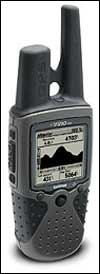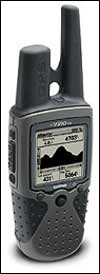Quite a trip, John! Peacock bass are serious fishbig, tough, and aptly named, given their orange, olive, and green coloration.
 Rino 130
Rino 130
And there are a few devices that might begin to meet your needs. One is the Garmin Rino 130, a combination GPS-radio (i.e., personal communicator) that includes basic maps of South America, though not real fine resolutioncities, rivers, highways, that sort of thing. But it’s a start. It’s a dual-mode radio, with both FRS (Family Radio Service) and GMRS (General Mobile Radio Service) capabilities. Using the FRS modewhich is the same as most “walkie-talkie” units used todayyields a range of two miles under good conditions. GMRS can take you up to five. And the Garmin links the radio and GPS functions, so you can beam someone your location and they then can track to your location. Pretty cool! The only downside is the price$375 per unit (www.garmin.com).
An alternative is the Motorola i355, a wireless, GPS-enabled phone used by the Nextel network. It’s an extremely rugged phone that’s built for outdoor use and can take anything short of a full dunking. It works like a regular wireless phone; features Nextel’s very clever “push-to-talk” system that functions like a walkie-talkie with cross-country range; and has “off-the-network” radio capability, which gives you up to three miles of range. It is NOT, however, compatible with FRS units. Nor can you download any South America maps for itat least, not yet. Still, I’ve had a pair of these phones in hand for a month and am most impressed by them. It’s $90 with a service plan; $240 without (www.nextel.com).
To get on the right navigational track, check out ���ϳԹ��� Online’s all-new .


